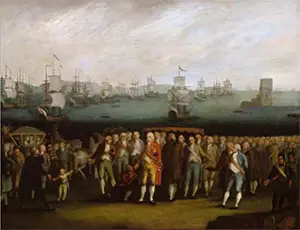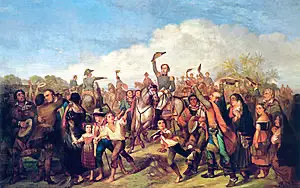Portuguese Rule of Brazil
Part 2: Colonization to Independence It was also human slaves (indigenous and Africa-imported) who worked in the mines in the 17th Century, in search of gold, first discovered in São Vicente at the end of the 16th Century but found in earnest only at the end of the following century. A gold rush ensued, resulting in the establishment of new settlements; as well, the royal coffers swelled with deposits from the Minas Gerais, as the Brazilian inland gold fields were known. Miners also found diamonds, in the early 18th Century. During this period, Portugal tried to muscle in on the silver trade in Spanish territory along the River Plate. After a few skirmishes, the two countries agreed to a 1750 treaty that allowed Portugal to expand the Brazilian colony to the southwest. Minas Gerais was the location of a political conspiracy known as the Incofidência Mineira. A group of nobles inspired by the American Revolution and the French Revolution planned to oust the colonial government and set up a democratic one. Portuguese authorities thwarted the uprising and dealt harshly with the leaders, exiling all but one of them to Angola and then mutilating the other, a man who came to be known as Tiradentes. 
In 1807, French troops invaded Portugal, as a way to attack the United Kingdom during the Napoleonic Wars. Portugal's John VI, then serving as prince regent for his mother, Queen Maria I, organized for the royal court to flee to Brazil. They arrived in Salvador in January 1808 and stayed for several years. John set about reorganizing Brazilian society— economically, culturally, and politically. He ended the monopoly that Portuguese companies had on trade with Brazil, allowing the U.K., in particular, as a trade partner. In the cultural realm, John established a wide variety of institutions, including a gunpowder factory, a botanical garden, a publishing house, institutes of medicine and other sciences, a handful of other educational programs, the Royal Museum, the National Library, and the royal theater. In the shadow of the Congress of Vienna, which in 1815 was redrawing the map of Europe, John created the United Kingdom of Portugal, Brazil and the Algarves. This effectively made Brazil a sovereign entity with the overall Portuguese U.K. The royal family continued to live in Brazil even after Portugal was free from foreign invaders. An uprising in his homeland in 1820 convinced John to return there. Queen Maria I had died in 1816, and John was officially King John VI. When he went back to Portugal, he left his oldest son and heir, First page > Discovery and Settlement > Page 1, 2 |
|
Social Studies for Kids
copyright 2002–2024
David White



 Pedro, in charge. Among the domestic uncertainty, the Portuguese
Pedro, in charge. Among the domestic uncertainty, the Portuguese 
